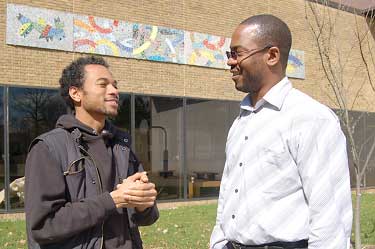Few who aspire to play in the NBA will make it, but counselor Brian Banks wants students to know that education is a slam dunk.

Banks, for seven years an academic programs assistant in the School of Art & Design, once dreamed of making it as a player. Now when he attends an NBA game he’s not only cheering for the players but for the people working from the sidelines, such as athletic trainers, video coordinators, television analysts, and telecommunications-computer specialists—people who may have wanted to make it as players but who found a plan to succeed off the court.
“A lot of athletes won’t go pro. Will they have a plan or fall by the wayside? Education opens doors,” Banks says.
It was while encouraging youth at New Testament Baptist Church in Ypsilanti, where he serves as an usher, that Banks was inspired to write a book about his insight into careers and basketball, “How to make it to the NBA: a more realistic approach.”
Banks says he wanted to show young men who needed guidance the kind of careers they could receive with a college degree. His efforts included taking them on a field trip to the Palace of Auburn Hills, for a tour and career introduction. “I don’t want to live and die; I want to touch lives,” Banks says.
Banks wasn’t a particularly inspired student until high school. That’s when he met a teacher, Frances Deckard, who challenged and inspired him to succeed.
“She knew when to give us a kick in the butt and when to give us a hug,” says Banks, who went on to attend Concordia University and Washtenaw Community College (WCC). Banks since has helped establish the Deckard Brown Scholarship at WCC, to honor his former mentor.
Currently he helps art and design students navigate their careers and classes leading up to graduation. While students may make decisions based on their parents or friends, Banks advises against it. “Follow your heart. You’ll be happier and overall things will fall into place.”
Banks’ workspace is a wonderland of creations from handmade edible sculptures to scarves made of fluorescent rubber bands. A workday can involve a range of activities, including walk-in advising sessions, enrollment of students, and staff and student meetings.
When Banks takes parents on a tour of the campus, he’ll often get questions concerning career choices; they’re not sure how their child will make a living in the arts. “People tend to think of art as just painting or drawing. Art is connected to a lot of different industries, however, such as advertising, auto companies and magazines,” Banks responds.
The students in Art & Design have created vehicles, clothing, and upholstery for furniture; these are all skills transferable into other careers. “The students are bright, smart and talented; I feel fortunate to be working here,” he says, adding there’s no better feeling than the joy of seeing students walk across the stage to obtain their degrees, knowing he played a small role in their success.

